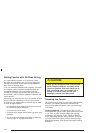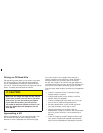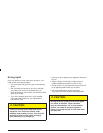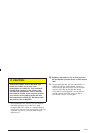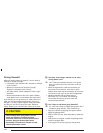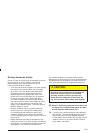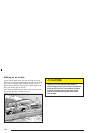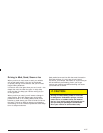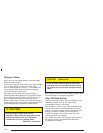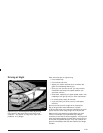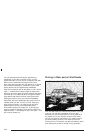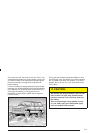
Driving Downhill
When off-roading takes you downhill, you will want to
consider a number of things:
• How steep is the downhill? Will I be able to maintain
vehicle control?
• What is the surface like? Smooth? Rough?
Slippery? Hard-packed dirt? Gravel?
• Are there hidden surface obstacles? Ruts? Logs?
Boulders?
• What is at the bottom of the hill? Is there a hidden
creek bank or even a river bottom with large rocks?
If you decide you can go down a hill safely, then try to
keep your vehicle headed straight down, and use a
low gear. This way, engine drag can help your brakes
and they will not have to do all the work. Descend
slowly, keeping your vehicle under control at all times.
{CAUTION:
Heavy braking when going down a hill can
cause your brakes to overheat and fade.
This could cause loss of control and a serious
accident. Apply the brakes lightly when
descending a hill and use a low gear to keep
vehicle speed under control.
Q: Are there some things I should not do when
driving down a hill?
A: Yes! These are important because if you ignore
them you could lose control and have a serious
accident.
• When driving downhill, avoid turns that take you
across the incline of the hill. A hill that is not too
steep to drive down may be too steep to drive across.
You could roll over if you do not drive straight down.
• Never go downhill with the transmission in
NEUTRAL (N). This is called “free-wheeling.”
Your brakes will have to do all the work and
could overheat and fade.
Q: Am I likely to stall when going downhill?
A: It is much more likely to happen going uphill. But if
it happens going downhill, here is what to do.
• Stop your vehicle by applying the regular brakes.
Apply the parking brake.
• Shift to PARK (P) and, while still braking, restart the
engine.
• Shift back to a low gear, release the parking brake,
and drive straight down.
• If the engine will not start, get out and get help.
4-34





